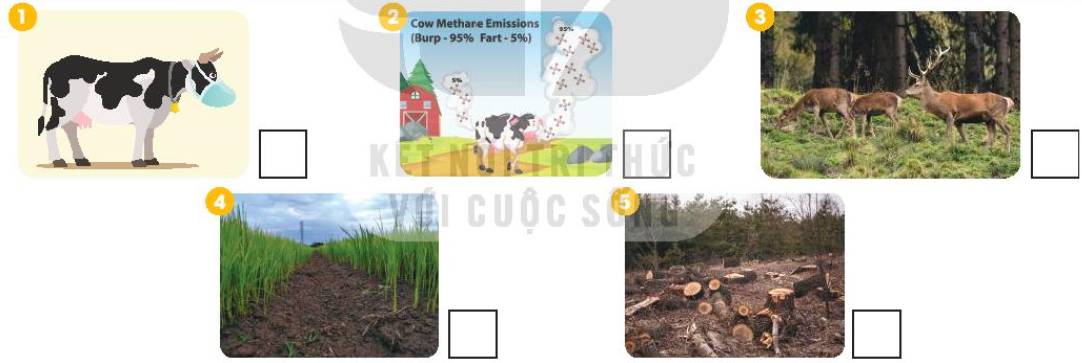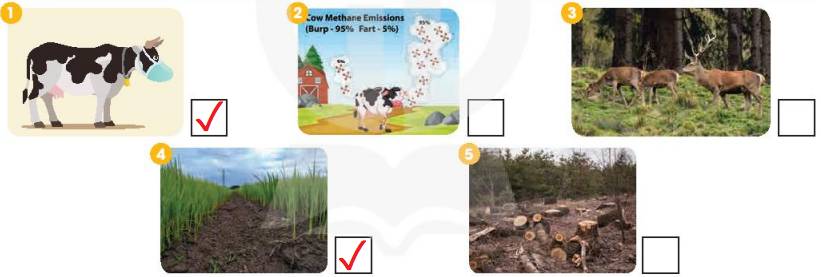Hãy nhập câu hỏi của bạn vào đây, nếu là tài khoản VIP, bạn sẽ được ưu tiên trả lời.

Tham khảo:
There are several farming activities in Vietnam that can have a negative impact on the global temperature, including:
1. Rice cultivation: Rice cultivation is a major source of greenhouse gas emissions, primarily due to the production of methane during the decomposition of organic matter in flooded rice paddies.
2. Livestock production: Livestock production, particularly from cattle and buffalo, is a significant contributor to greenhouse gas emissions through the production of methane from enteric fermentation and manure management.
3. Pesticide use: Pesticide use in agriculture can lead to the emission of greenhouse gases, particularly nitrous oxide, as well as contribute to soil degradation.
4. Deforestation: Deforestation for agriculture, particularly for expanding rice paddies or livestock grazing areas, can contribute to the release of carbon dioxide into the atmosphere.
To address these negative impacts, some alternatives that can be considered include:
1. Sustainable rice cultivation: Alternative rice cultivation methods, such as aerobic rice cultivation or the use of alternate wetting and drying methods, can significantly reduce methane emissions from rice paddies.
2. Improved livestock management: Improved livestock management practices, such as better feeding and manure management, can reduce the emissions of methane and other greenhouse gases.
3. Organic farming: Organic farming practices, including the use of natural pest control methods and composting, can reduce the use of pesticides and fertilizers, as well as promote soil health.
4. Forest conservation and reforestation: Conservation and reforestation efforts can help to reduce the release of carbon dioxide from deforestation and promote carbon sequestration in new forest areas.
Overall, a shift towards sustainable agriculture practices and land use management can help to mitigate the negative impacts of farming activities on the global temperature.

Sophie: Hey John, have you heard about the different human activities that contribute to global warming?
John: Yeah, I have heard about some of them, like cutting down forests and burning fossil fuels.
Sophie: That’s right. Cutting down or burning forests releases carbon dioxide, but burning coal, oil, and gas also contribute to global warming. When fossil fuels are burnt, they release greenhouse gases that trap heat in the atmosphere.
John: That’s really interesting. I didn’t know that. Are there any other human activities that contribute to global warming?
Sophie: Yes, there are. For example, raising farm animals like goats, sheep, and cows also contributes to global warming. These animals produce a lot of methane, which is responsible for nearly one-third of current global warming.
John: Wow, I had no idea that raising farm animals had such a big impact on the environment. What about the impact of cutting down forests for farming?
Sophie: That’s a good point. Cutting down forests to make space for farm animals also contributes to global warming. Forests store carbon in the trees and soil, and help reduce the global temperature. When forests are cut down, the carbon is released into the atmosphere, which contributes to global warming.
John: Thanks for sharing all this information with me, Sophie. It’s really eye-opening to learn about the different human activities that contribute to global warming.
Tạm dịch:
Sophie: Này John, bạn đã nghe nói về các hoạt động khác nhau của con người góp phần vào sự nóng lên toàn cầu chưa?
John: Vâng, tôi đã nghe nói về một số trong số chúng, chẳng hạn như chặt phá rừng và đốt nhiên liệu hóa thạch.
Sophie: Đúng vậy. Chặt phá hoặc đốt rừng giải phóng carbon dioxide, nhưng đốt than, dầu và khí đốt cũng góp phần vào sự nóng lên toàn cầu. Khi nhiên liệu hóa thạch bị đốt cháy, chúng giải phóng khí nhà kính giữ nhiệt trong khí quyển.
John: Điều đó thực sự thú vị. Tôi không biết điều đó. Có bất kỳ hoạt động nào khác của con người góp phần vào sự nóng lên toàn cầu?
Sophie: Vâng, có. Ví dụ, chăn nuôi gia súc như dê, cừu và bò cũng góp phần vào sự nóng lên toàn cầu. Những động vật này tạo ra rất nhiều khí mê-tan, là nguyên nhân gây ra gần một phần ba sự nóng lên toàn cầu hiện nay.
John: Ồ, tôi không biết rằng việc chăn nuôi động vật trong trang trại lại có tác động lớn đến môi trường như vậy. Còn tác động của việc chặt phá rừng để canh tác thì sao?
Sophie: Đó là một điểm tốt. Chặt phá rừng để tạo không gian cho động vật trang trại cũng góp phần vào sự nóng lên toàn cầu. Rừng lưu trữ carbon trong cây và đất, đồng thời giúp giảm nhiệt độ toàn cầu. Khi rừng bị đốn hạ, carbon được giải phóng vào khí quyển, góp phần làm nóng lên toàn cầu.
John: Cảm ơn vì đã chia sẻ tất cả thông tin này với tôi, Sophie. Việc tìm hiểu về các hoạt động khác nhau của con người góp phần vào sự nóng lên toàn cầu thực sự rất thú vị.

Work in pairs. Read the following ideas and decide if they are pros or cons of self-study. Think of other pros and cons to add.
| Pros | Cons |
1. Self-study gives learners more freedom (e.g. they decide what to study and how). | ✔ |
|
2. Learners need more time to learn things (e.g. they work on their own, with no one to push them or help them). |
| ✔ |
3. Learners become responsible (e.g. they set their learning goals and make plans to achieve them). | ✔ |
|
4. Learners may not develop certain life skills (e.g. good communication and relationship skills) |
| ✔ |
5. Self-study makes learners confident ( e.g. they realise they can complete tasks by themselves) | ✔ |
|
6. Learners may not learn practical skills (e.g. they may focus too much on learning, and may not apply the academic skills to real life) | ✔ |

community service is work done by a person or group of people that benefits others.it is often done near the area where you live ,so your own community gets the benefits of your work .you do not get paid to perform community service , but get to learn alot. community service can help many different groups of people,even animals and the environment . community service is often organized through a local group ,such as a place of worship , school,or non-profit organization ,or you can start your owncommunity service projects.community service can event involve raising funds by doneting used goods or selling used goods like clothing
many pepople participate in community service because they enjoy help others and improving their community.
1.what is community service?
.......................community service is work done by a person or group of people that benefits others............................................
2,where is community service often done ?
.............................it is often done near the area where you live ....................................................
3.Is community service a playing job ?
.........................no, it isn't...................................................
4.what groups of people can community service help?
................community service can help many different groups of people,even animals and the environment ..............................
5. Is donation of used goods a community service example?
...............Yes, it is................................................
6. why do many people take part in community service?
......................................
many pepople participate in community service because they enjoy help others and improving their community.
...................................

There are several actions that individuals and governments can take to reduce global warming:
1. Reduce energy consumption: One of the main sources of greenhouse gas emissions is the burning of fossil fuels to produce energy. We can reduce energy consumption by turning off lights and appliances when not in use, using energy-efficient light bulbs and appliances, and reducing the use of air conditioning and heating.
2. Use renewable energy sources: Renewable energy sources such as solar, wind, and hydropower emit little to no greenhouse gases. Governments can invest in renewable energy infrastructure, and individuals can install solar panels on their homes or participate in community solar programs.
3. Reduce, reuse, and recycle: The production of goods and the disposal of waste are also sources of greenhouse gas emissions. By reducing the amount of waste we generate, reusing products as much as possible, and recycling materials, we can reduce emissions and conserve resources.
4. Plant trees and conserve forests: Trees absorb carbon dioxide from the atmosphere, so planting trees and conserving forests can help reduce greenhouse gas emissions.
5. Support climate-friendly policies and actions: Governments can implement policies and actions that promote clean energy, reduce emissions, and protect the environment. As individuals, we can also support these policies and take action to reduce our own emissions.
Mọi người đều có thể giúp hạn chế biến đổi khí hậu. Từ cách di chuyển, đến cách tiêu thụ điện và thực phẩm, chúng ta có thể tạo ra sự khác biệt. Hãy bắt đầu với mười hành động này để giải quyết cuộc khủng hoảng khí hậu.

2. emission - deforestation
3. fossil fuels - greenhouse effects



 contributes to global warming.
contributes to global warming. ending def _________
ending def _________  at the COP.
at the COP. has increased the amount of gre______ ________
has increased the amount of gre______ ________  in the earth's atmosphere.
in the earth's atmosphere.
Human is the direct factor that causes global warming and makes this phenomenon more and more serious. The reason is because the increase in CO2 content is mainly due to human activities, such as fuel burning, the reduction in agricultural land use, especially after the industrial revolution.
Helping limited global warming, we should:
1. Drive less
Walk, bike, carpool or take mass transit more often. You'll save one pound of carbon dioxide for every mile you don't drive!
2. Avoid products with a lot of packaging
You can save 1,200 pounds of carbon dioxide if you reduce your garbage by 10 percent.
3. Plant more trees
A single tree will absorb one ton of carbon dioxide over its lifetime.
4. Turn off electronic devices
Simply turning off your television, DVD player, stereo, and computer, when you're not using them, will save you thousands of pounds of carbon dioxide a year.